#include <llinearpiecewisefunction.h>

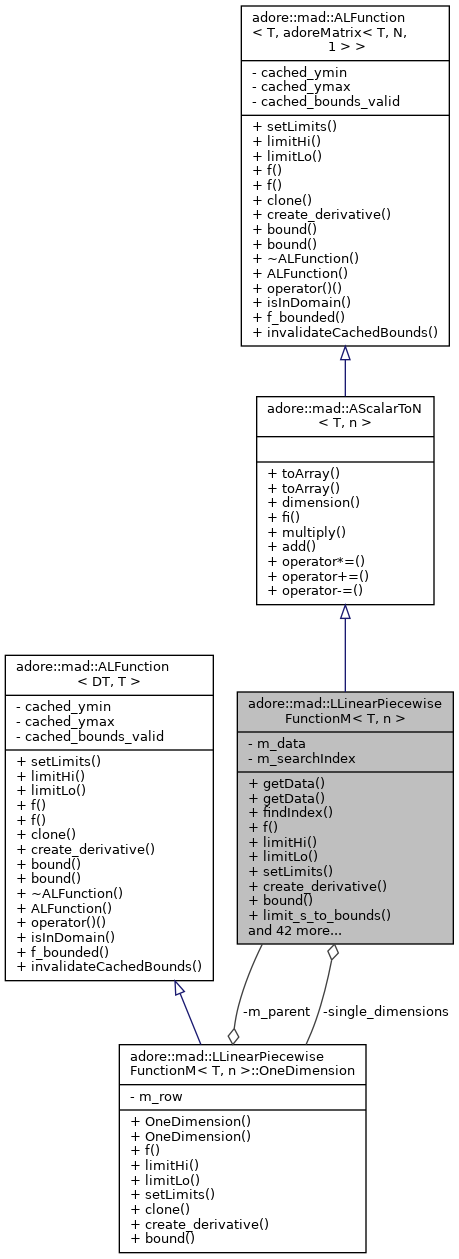
Classes | |
| class | OneDimension |
Public Types | |
| typedef adoreMatrix< T, n, 1 > | CT |
| typedef AScalarToN< T, n >::DT | DT |
 Public Types inherited from adore::mad::AScalarToN< T, n > Public Types inherited from adore::mad::AScalarToN< T, n > | |
| typedef T | DT |
| typedef adoreMatrix< T, N, 1 > | CT |
| typedef ALFunction< DT, T > | SUBFUN |
Public Member Functions | |
| adoreMatrix< T, n+1, 0 > & | getData () |
| const adoreMatrix< T, n+1, 0 > & | getData () const |
| unsigned int | findIndex (DT x, DT precision=0.001) const |
| virtual CT | f (DT x) const override |
| virtual DT | limitHi () const override |
| virtual DT | limitLo () const override |
| virtual void | setLimits (DT lo, DT hi) override |
| virtual ALFunction< DT, CT > * | create_derivative () override |
| virtual void | bound (const DT &xmin, const DT &xmax, CT &ymin, CT &ymax) override |
| virtual double | limit_s_to_bounds (double s) const |
| shifts s to be in between limitLo and limitHi More... | |
| virtual void | invertDomain () |
| virtual void | startDomainAtZero () |
| void | shiftDomain (DT dx) |
| virtual void | stretchDomain (DT x0, DT x1) |
| void | shiftCodomain (CT dy) |
| void | shiftCodomain (T dy, int i=0) |
| void | rotateXY (double angle, double x0=0.0, double y0=0.0) |
| virtual T | fi (DT x, int row) const override |
| virtual T | dfidx (DT x, int row) |
| void | sample_dfidx (DT *xvec, T *yvec, int count, int row) |
| virtual ALFunction< DT, T > * | dimension (int i) override |
| LLinearPiecewiseFunctionM () | |
| LLinearPiecewiseFunctionM & | operator= (const LLinearPiecewiseFunctionM &other) |
| LLinearPiecewiseFunctionM (const LLinearPiecewiseFunctionM &other) | |
| LLinearPiecewiseFunctionM (const adoreMatrix< T, n+1, 0 > &data) | |
| LLinearPiecewiseFunctionM (const adoreMatrix< T, 1, 0 > &xdata, const adoreMatrix< T, n, 0 > &ydata) | |
| LLinearPiecewiseFunctionM (const int nc, T value) | |
| virtual | ~LLinearPiecewiseFunctionM () |
| virtual ALFunction< DT, CT > * | clone () override |
| void | setData (const adoreMatrix< T, n+1, 0 > &data) |
| virtual void | multiply (adoreMatrix< T, 0, 0 > A, int rowi, int rowj) override |
| virtual void | add (adoreMatrix< T, 0, 1 > b, int rowi, int rowj) override |
| std::vector< std::pair< T, T > > * | getIntersections2d (LLinearPiecewiseFunctionM< T, n > *other, int dim1, int dim2) |
| std::vector< std::pair< T, T > > * | getIntersections2d (LLinearPiecewiseFunctionM< T, n > *other) |
| bool | getFirstIntersection2d (LLinearPiecewiseFunctionM< T, n > *other, int dim1, int dim2, std::pair< T, T > &result) |
| bool | getFirstIntersection2d (LLinearPiecewiseFunctionM< T, n > *other, std::pair< T, T > &result) |
| bool | getFirstIntersection1d (T y_cross, int dimension, T &x) |
| bool | getFirstIntersection1d (T y_cross, T &x) |
| bool | getFirstIntersection1d (LLinearPiecewiseFunctionM< T, n > *other, int dim, std::pair< T, T > &result) |
| bool | getNextIntersectionWithLine2d (T x0, T px, T py, T vx, T vy, int d1, int d2, T &x_result, T &distance, bool extend_fringes=false, bool inside_input_line=false) |
| bool | getNextIntersectionWithLine2d (T x0, T px, T py, T vx, T vy, T &x_result, T &distance, bool extend_fringes=false) |
| bool | getNextIntersectionWithVector2d (T x0, T px, T py, T vx, T vy, T &x_result, T &distance, T max_distance, bool extend_fringes=false) |
| int | countIntersectionsWithRay2d (T px, T py, int d1, int d2, T ex, T ey, bool inverted=false) |
| double | getPositionOfPoint (T px, T py, int d1, int d2, T &d_tangential_min, T &d_normal_min) |
| double | getClosestParameter (T px, T py, int d1, int d2, T &n_min) const |
| double | getClosestParameter_local (T px, T py, int d1, int d2, T x0, T *n_min=nullptr) const |
| double | getClosestParameter (T px, T py, int d1, int d2) const |
| bool | isPointEnclosed (LLinearPiecewiseFunctionM< T, n > *other, T px, T py, int d1, int d2, bool invert_this=false, bool invert_other=true) |
| T | getXAfterNPoints (T xstart, int N) |
| void | writePointsToArray (int i, int j, T *m) |
| void | writePointsToArray (int i, int j, int d, T *m) |
| int | export_points (adoreMatrix< double, 0, 0 > &target, double x0, double x1, double precision) |
 Public Member Functions inherited from adore::mad::AScalarToN< T, n > Public Member Functions inherited from adore::mad::AScalarToN< T, n > | |
| void | toArray (DT *xvec, T *yvec, unsigned int count) |
| void | toArray (DT *xvec, T *yvec, unsigned int count, unsigned int row) |
| virtual T | fi (DT x, int dim) const=0 |
| virtual void | operator*= (adoreMatrix< T, N, N > A) |
| virtual void | operator+= (adoreMatrix< T, N, 1 > b) |
| virtual void | operator-= (adoreMatrix< T, N, 1 > b) |
 Public Member Functions inherited from adore::mad::ALFunction< T, adoreMatrix< T, N, 1 > > Public Member Functions inherited from adore::mad::ALFunction< T, adoreMatrix< T, N, 1 > > | |
| virtual void | setLimits (T lo, T hi)=0 |
| virtual adoreMatrix< T, N, 1 > | f (T x) const=0 |
| virtual void | f (T *xvec, adoreMatrix< T, N, 1 > *yvec, unsigned int count) const |
| virtual void | bound (const T &xmin, const T &xmax, adoreMatrix< T, N, 1 > &ymin, adoreMatrix< T, N, 1 > &ymax)=0 |
| void | bound (adoreMatrix< T, N, 1 > &ymin, adoreMatrix< T, N, 1 > &ymax) |
| virtual | ~ALFunction () |
| ALFunction () | |
| const adoreMatrix< T, N, 1 > | operator() (T x) const |
| bool | isInDomain (T x) |
| adoreMatrix< T, N, 1 > | f_bounded (T x) |
| void | invalidateCachedBounds () |
Private Attributes | |
| adoreMatrix< T, n+1, 0 > | m_data |
| unsigned int | m_searchIndex |
| OneDimension | single_dimensions [n] |
LPiecewiseFunction - a linear interpolation function based on a matrix object, f: DT^1 --> T^n
| typedef adoreMatrix<T, n, 1> adore::mad::LLinearPiecewiseFunctionM< T, n >::CT |
| typedef AScalarToN<T,n>::DT adore::mad::LLinearPiecewiseFunctionM< T, n >::DT |
|
inline |
constructor without initialization
|
inline |
copy constructor
|
inline |
constructor: initialize with data matrix containing domain and codomain
|
inline |
constructor: initialize with two data matrices containing domain and codomain separately
|
inline |
constructor: dynamically sized matrix, initialized with a single value
|
inlinevirtual |
|
inlineoverridevirtual |
apply operation to function sub-dimensions: add vector b to dimensions rowi to rowj
Implements adore::mad::AScalarToN< T, n >.

|
inlineoverridevirtual |


|
inlineoverridevirtual |
create a copy of child class object - is used for function operations
Implements adore::mad::ALFunction< T, adoreMatrix< T, N, 1 > >.

|
inline |
countIntersectionsWithRay2d - sends a ray starting at px,py in direction of x axis and counts intersections with the lines of this object. dimensions d1 and d2 are used. furthermore, an extension point (ex,ey) is given, which allows to test another line from last point to (ex,ey) The method can be used to test for a point (px,py) whether it is inside the polygon defined by this function object: Unequal number of intersections <=> point is inside specify (ex,ey) as first point of this function object to close the loop of the line sequence. specify (ex,ey) as first point fo next function object to test line sequence consisting of multiple function objects https://en.wikipedia.org/wiki/Point_in_polygon

|
inlineoverridevirtual |
create a new function object, which is the derivative function
Implements adore::mad::ALFunction< T, adoreMatrix< T, N, 1 > >.
|
inlinevirtual |
numerical gradient: get a singular value from vector codomain type


|
inlineoverridevirtual |
get access to a scalar version of this function
Implements adore::mad::AScalarToN< T, n >.

|
inline |
export points between x0 and x1 values to a matrix

|
inlineoverridevirtual |

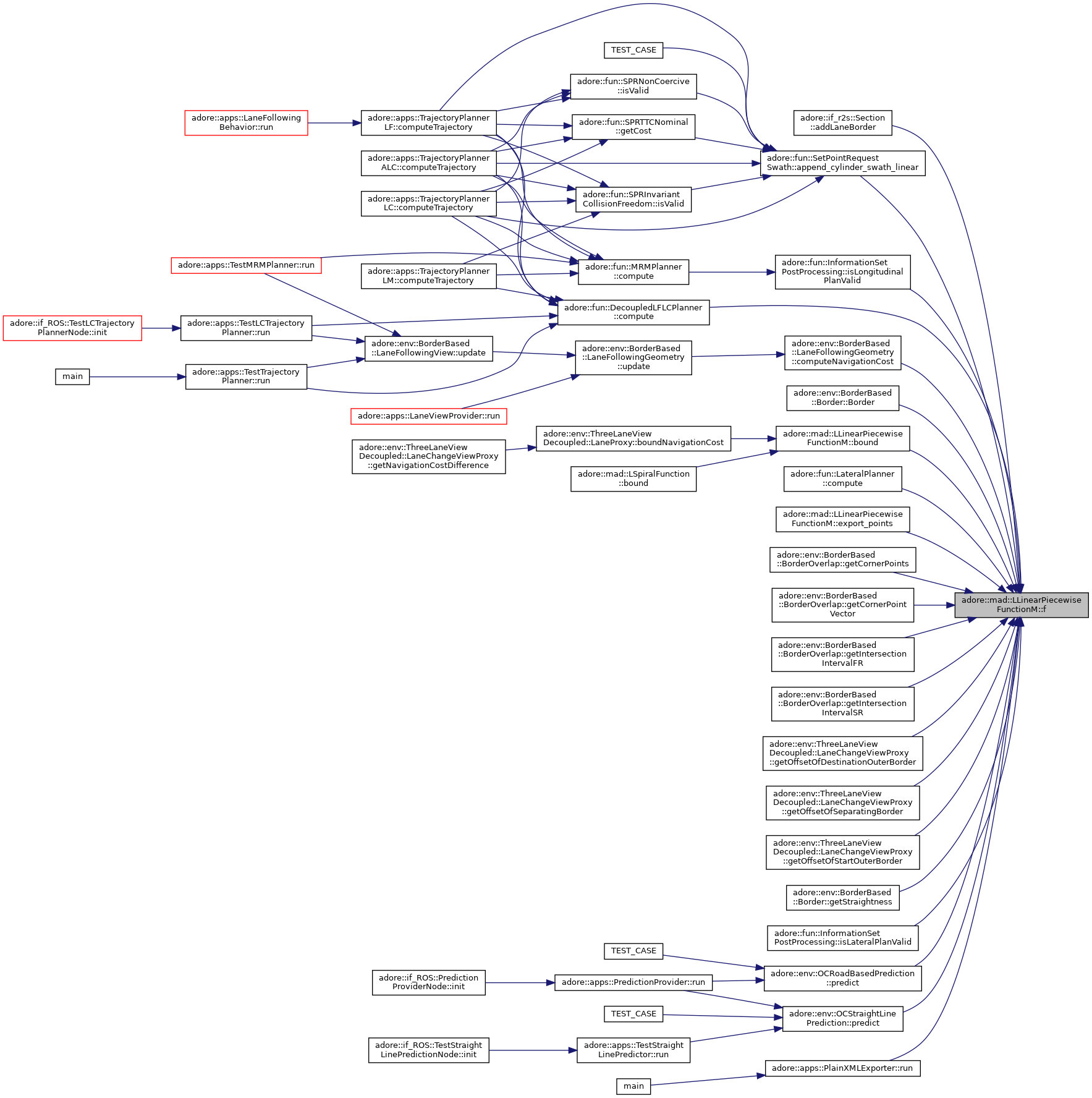
|
inlineoverridevirtual |
get a singular value from vector codomain type

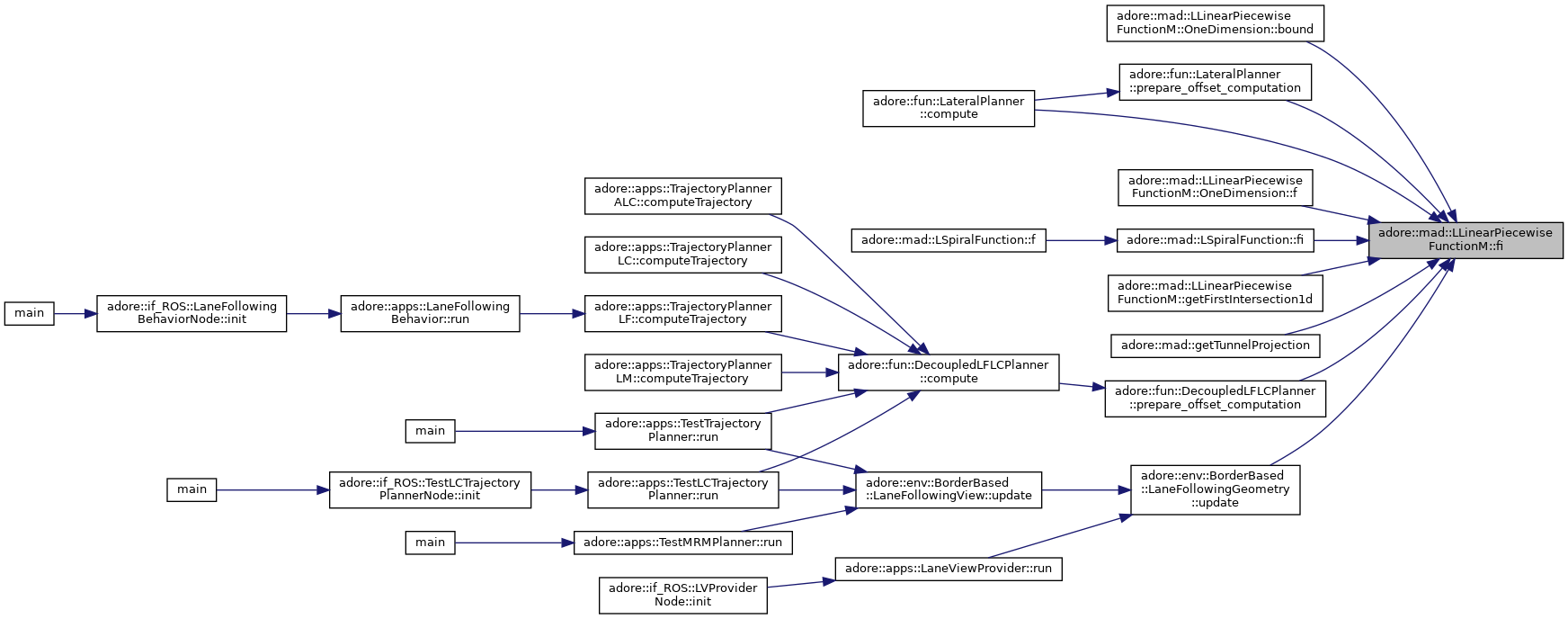
|
inline |

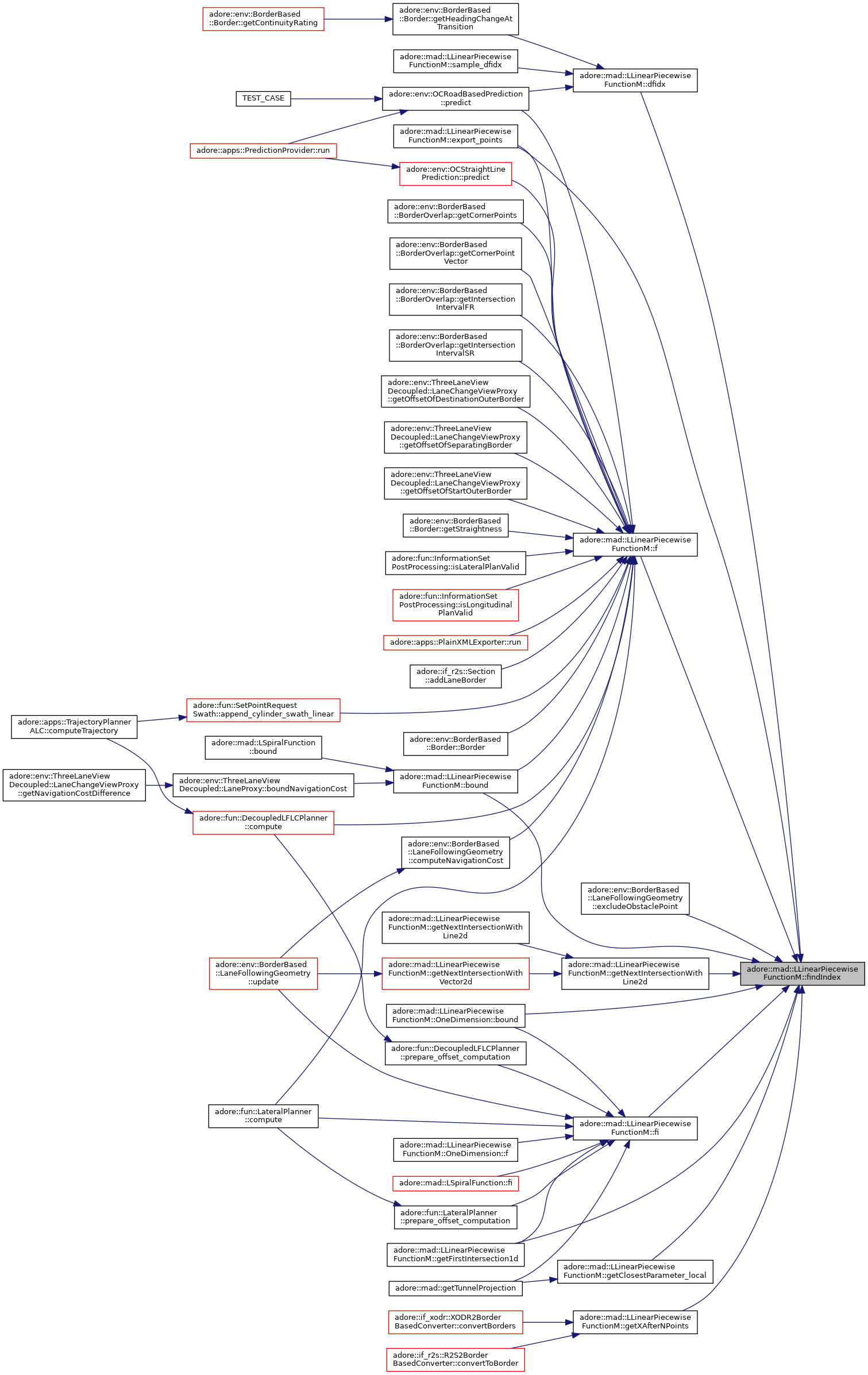
|
inline |

|
inline |
returns the parameter of the function value at dimensions d1,d2 with closest euclidean distance to px,py

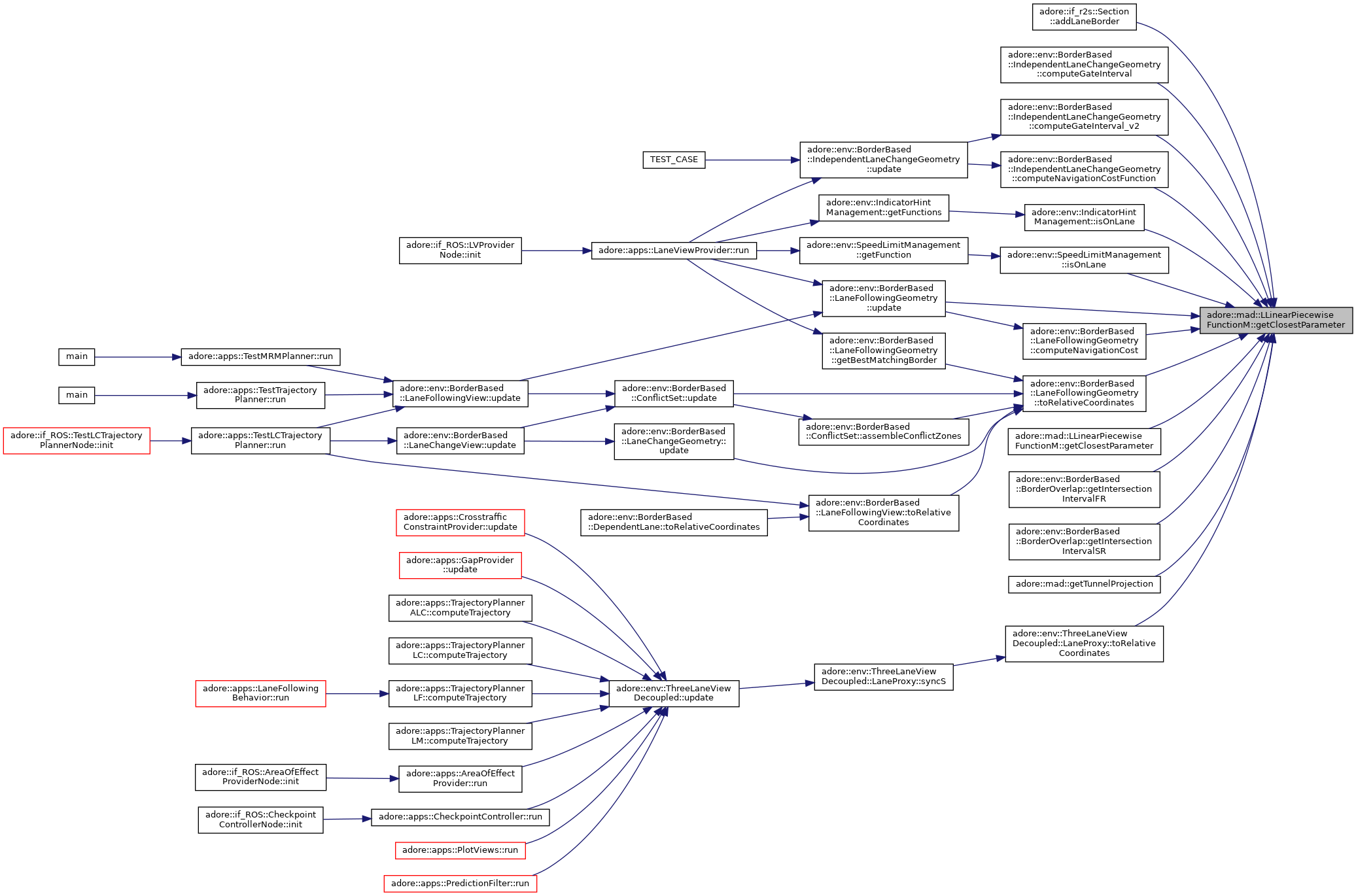
|
inline |
returns the parameter of the function value at dimensions d1,d2 with closest euclidean distance to px,py, local search starting at x0


|
inline |
|
inline |
|
inline |
one dimensional intersection test
| dim | dimension to be tested |
| result | first intersection: domain values of intersection point |
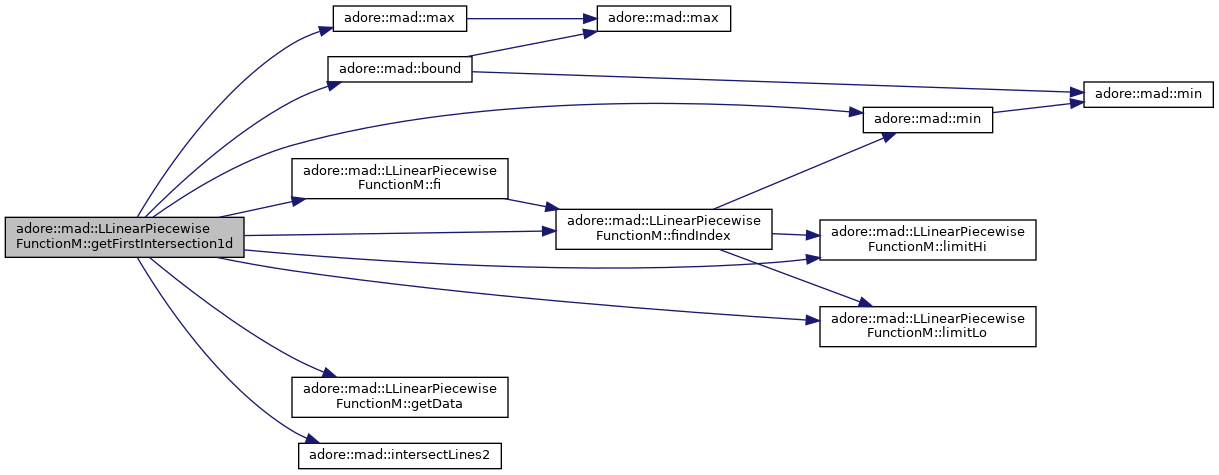
|
inline |
getFirstIntersection1d - zero crossing test returns true, if a "zero" crossing happens tests for crossing y_cross value in dimension "dimension" the x coordinate is written in x, if a crossing occurs


|
inline |

|
inline |
computes the first intersection between two line sequences, with first seen from perspective of this returns true if an intersection was found and then writes domain values for intersection into result, with first for this and second for other.
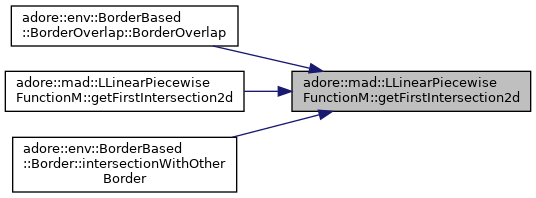
|
inline |

|
inline |

|
inline |
test whether this and other intersect in dimension d1 and d2 - a vector of pairs of x-values (domain) is returned, with one entry for every intersection and the first entry in a pair for this and the second entry for other

|
inline |
getNextIntersectionWithLine2d - returns the next x-position after x0, at which the line with start (px,py) and direction (vx,vy) intersects this in dimensions d1,d2. returns true if an intersection was found after x0 sets x_result to the parametrization of this at which intersection occurs, e.g. ip = f_d1d2(x_result); sets distance to the parameter required to achieve the intersection point via the given line, e.g. ip=(px,py) + (vx,vy)*distance; extend_fringes - if extend_fringes is true, the function is extrapolated in order to provide intersection points beyond its domain


|
inline |

|
inline |


|
inline |
getPositionOfPoint - returns best-fit d_tangential and d_normal: if d_tangential>1 or d_tangential<0, the point is not projected onto function interval the according function parameter for given point is returned
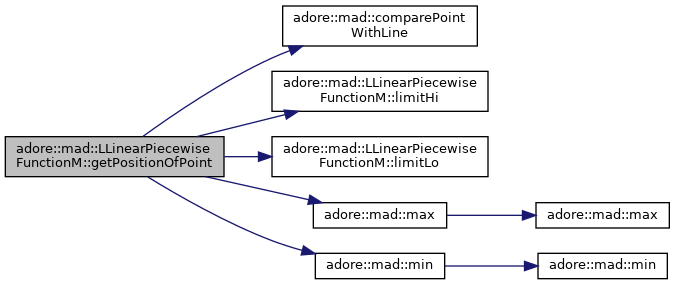

|
inline |
returns the x-value if going forward N points


|
inlinevirtual |
retains the overall domain between lo and hi, but inverts direction in between


|
inline |
isPointEnclosed - Returns true if a point x is enclosed by the two line segments this, other and the lines connecting this' and other's endpoints. This and other have to form a counter clockwise loop if their endpoints are connected, so that the interior of the loop is well defined. If this and other do not form a ccw loop, use invert_this or invert_other to temporarily change directions, to achieve ccw loop. https://en.wikipedia.org/wiki/Point_in_polygon


|
inlinevirtual |
|
inlineoverridevirtual |
query upper limit of the domain
Implements adore::mad::ALFunction< T, adoreMatrix< T, N, 1 > >.
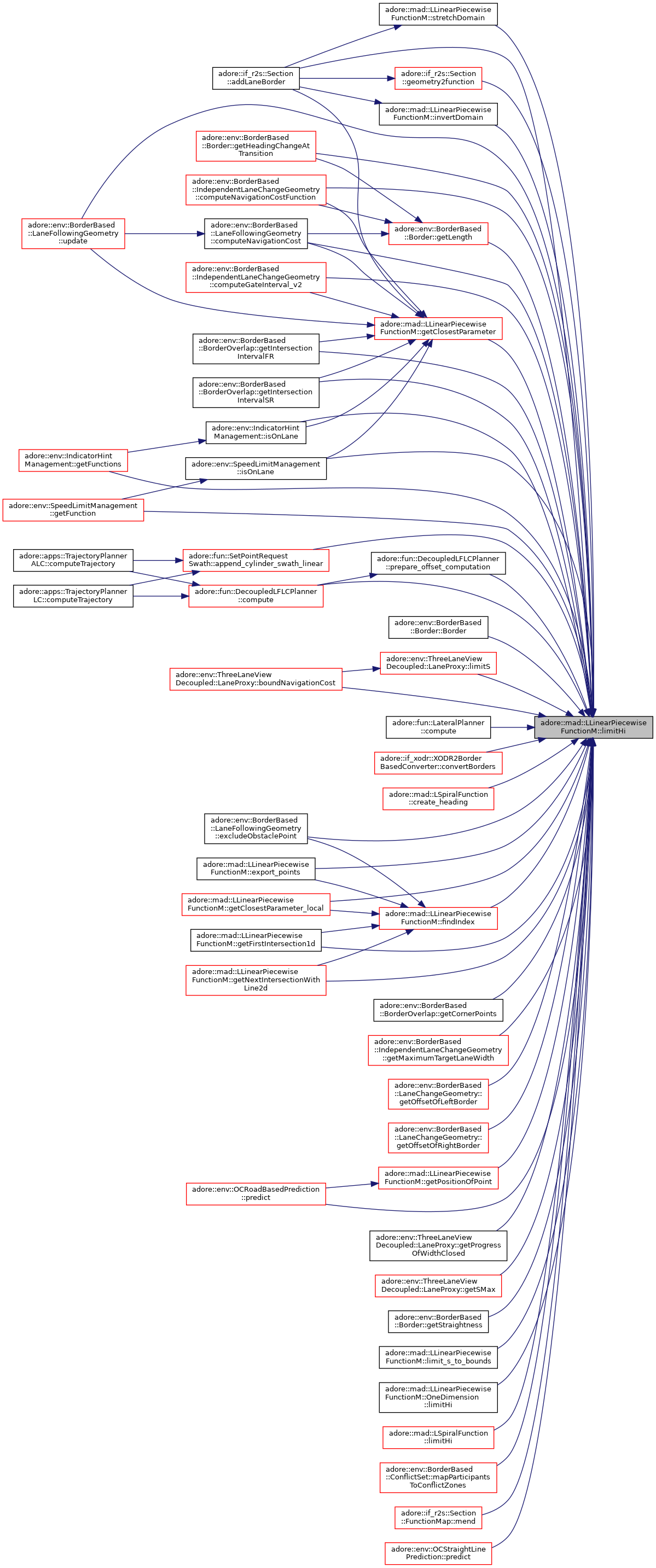
|
inlineoverridevirtual |
lower limit of the domain
Implements adore::mad::ALFunction< T, adoreMatrix< T, N, 1 > >.
|
inlineoverridevirtual |
apply operation to function sub-dimensions: multiply with matrix of lower dimension in range rowi to rowj, with A.nc==A.nr==rowj-rowi+1
Implements adore::mad::AScalarToN< T, n >.

|
inline |
|
inline |
rotate codomain in 2D


|
inline |
sapmle a range of x values and evaluate gradient for one row of the vector only

|
inline |
set the domain and codomain from data matrix

|
inlineoverridevirtual |

|
inline |
shifts the codomain of the function (move graph up or down)

|
inline |
shift a single dimension of the codomain
|
inline |
shifts the domain of the function by dx (move graph left or right)

|
inlinevirtual |
shifts the function in such a way that the domain starts at 0

|
inlinevirtual |
stretches domain to fit interval [x0,x1]


|
inline |
writes j-i points into an array m, for dimension d, using the natural stepsize
|
inline |
writes j-i points into an array m, using the natural stepsize
|
private |
|
mutableprivate |
|
private |